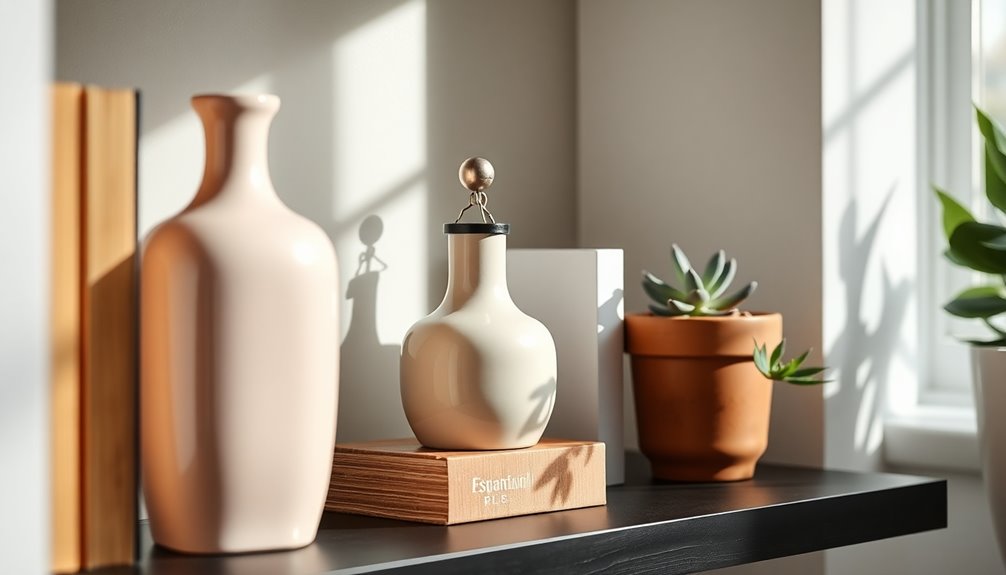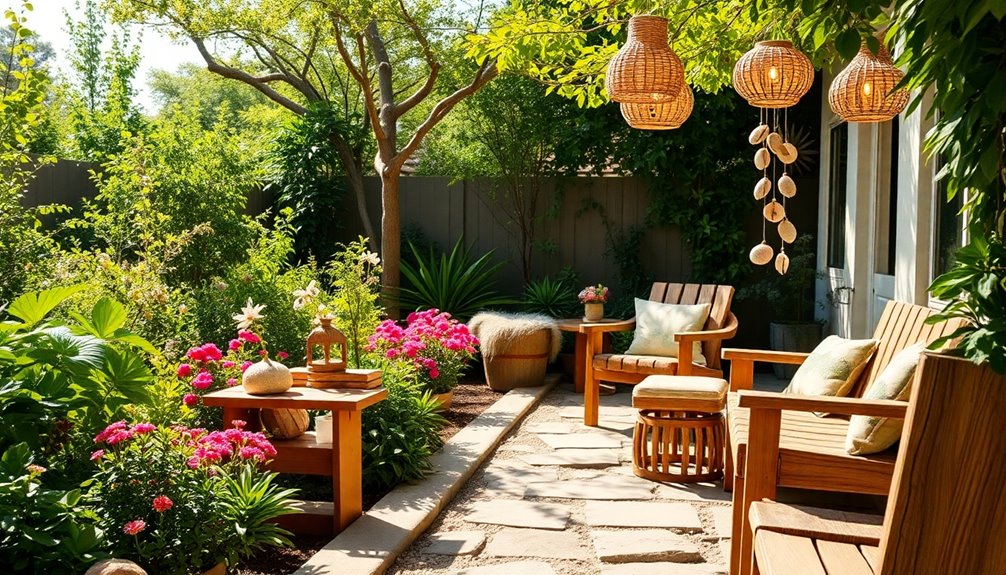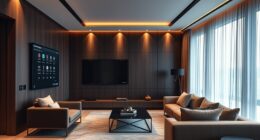To curate shelves that look designer-approved, start by balancing aesthetics with functionality. Use a cohesive color palette to guarantee harmony, and layer items for depth. Place larger pieces at the back, and arrange medium and smaller accessories in front. Group items in odd numbers for visual interest and embrace asymmetry. Incorporate meaningful items like travel souvenirs or heirlooms to add character. Don't forget to mix textures and introduce greenery for vibrancy. By following these tips, you'll create a stunning visual display. There's much more to discover about achieving that designer look, so keep going for additional insights.
Key Takeaways
- Choose a cohesive color palette that complements your decor to create harmony and avoid visual clutter.
- Layer items by placing larger pieces at the back and smaller ones in front for depth and interest.
- Group accessories in odd numbers and embrace asymmetry to achieve a dynamic and curated look.
- Incorporate meaningful items that tell a story, such as travel souvenirs or family heirlooms, to enhance personal connection.
- Mix functional items with decorative pieces and include greenery for added vibrancy and visual contrast.
Understanding Shelf Design

When it comes to shelf design, striking the right balance between aesthetics and functionality is vital. Your shelves can transform a simple space into a visually appealing focal point, so it's important to reflect on how you style them. Accessories play an important role in this process. By thoughtfully selecting decorative items, you create a curated look that reflects your personal style while enhancing the overall atmosphere of the room.
To achieve a cohesive color palette, choose accessories that complement each other and the surrounding decor. This approach not only elevates the shelves but also creates a harmonious flow throughout the space. Remember, personalization is key—incorporate art and unique pieces that resonate with you, adding character and warmth.
Additionally, don't forget about functionality. Your shelves should serve a purpose, whether it's displaying books or showcasing cherished items. Understanding the balance between form and function guarantees your displays are stylish yet usable for everyday life. For instance, you might want to utilize plants as decorative elements that not only enhance the visual appeal but also improve air quality.
Engaging quality design talent can further elevate your shelf projects, turning them into artistic expressions that are both striking and practical. With these elements in mind, you're well on your way to curating designer-approved shelves.
Essential Styling Techniques

To create visually appealing shelves, start by layering your items to add depth and interest. Group accessories in odd numbers for a more dynamic display, ensuring each piece complements the others. Additionally, incorporating rustic creations like handmade ceramics can enhance the overall charm of your shelf styling. Consider the color palette of your items to create a harmonious and cohesive look that ties the shelves together. Utilizing unique pieces from your collection can also serve as great conversation starters, enriching the overall aesthetic of your display. To elevate the ambiance of your shelves, think about adding natural elements that promote tranquility and enhance the overall vibe.
Layering for Visual Interest
Layering your shelves effectively can transform a simple display into an eye-catching focal point. Start by placing larger, sculptural pieces at the back. This creates a strong foundation for your display and draws the eye.
Next, introduce medium and smaller accessories in front or to the side, ensuring they complement the larger items without overwhelming them.
To enhance visual interest, utilize a triangular or diagonal layout. This guides the eye across the shelf, creating a dynamic flow. Additionally, mix vertical and horizontal book placements to add depth and texture. This combination allows for a more engaging composition.
When arranging your accessories, remember that grouping them in odd numbers—like threes or fives—creates a visually appealing and balanced look. This approach makes your display feel thoughtfully curated rather than cluttered. Incorporating natural materials like wood and stone can also enhance the overall farmhouse aesthetic of your shelving display.
Grouping Accessories Effectively
Grouping accessories effectively can elevate your shelf styling to new heights. Start by placing larger items at the back to establish a strong foundation and create depth in your arrangement. Incorporating mindfulness techniques while styling can help you focus on the present moment and enhance your creative expression.
Use a triangular or diagonal layout to guide the eye, guaranteeing your display is visually appealing and highlights key pieces. This approach is similar to how modern farmhouse style emphasizes open spaces and natural light for a spacious feel.
Incorporate both vertically and horizontally arranged books to add layers and balance, enhancing the overall aesthetic. Mixing orientations not only breaks up monotony but also draws attention to your accessories.
When grouping accessories, aim for odd numbers like threes or fives. This creates a dynamic composition that feels intentional and curated.
Don't forget to integrate greenery among your accessories. Plants add liveliness and texture, enhancing the visual interest of your shelf display.
For additional styling tips, consider the scale and color of your items. Mixing different heights can add drama, while a cohesive color palette guarantees harmony. Additionally, consider incorporating elements that reflect your personal style, similar to how modern bathroom design focuses on enhancing user experience through thoughtful integration of technology and aesthetics.
Color and Theme Considerations

When curating your shelves, stick to a cohesive color palette that complements your home's existing decor. Avoid mismatched colors that clash with your room's theme; instead, choose meaningful items that tell your story and enhance the overall aesthetic. Additionally, incorporating items that attract pollinators like bees can add a touch of nature to your curated space.
Cohesive Color Palette
To create a visually appealing shelf display, sticking to a cohesive color palette is essential. Start by selecting white or neutral tones that harmonize with your existing home decor. This approach helps you achieve a refined look that draws the eye and creates a cohesive look. Choosing toys made from natural materials can also enhance the aesthetic of your shelves while being visually appealing and safe for children.
Avoid mismatched color schemes; for instance, steer clear of clashing hues like pink in a primarily blue environment.
Utilize color blocking techniques to enhance visual interest while maintaining subtlety. Group similar color families for a curated appearance, allowing your decorative objects to shine without overwhelming the space. You can also incorporate pops of color through carefully chosen accessories. Just make sure these accents tie back to the overall aesthetic of your shelf and room.
Experiment with different shades within your chosen color palette to add depth and dimension. This strategy will keep your display engaging while adhering to the cohesive theme. Additionally, drawing on the power of imagination can inspire unique arrangements that reflect your personal style and creativity.
Meaningful Item Selection
Curate your shelf with meaningful items that tell your story and reflect your personal style. Start by selecting pieces that evoke personal stories or experiences, adding depth and character to your home decor. These meaningful items can spark conversation and make your space feel uniquely yours. Additionally, incorporating Indonesian art decor can bring a touch of cultural heritage and craftsmanship to your shelves. Moreover, consider how tax implications may affect your financial decisions when purchasing high-value items. Including items like authentic Indigenous art can further enhance the cultural significance of your collection and represent a commitment to supporting local artisans.
To achieve a cohesive look, consider sticking to white or neutral tones that seamlessly blend into your room's overall decor. Pull colors from existing elements in your home to maintain harmony and avoid mismatched palettes. This approach guarantees that your curated collection stands out while still feeling part of the overall aesthetic.
Explore antique centers, thrift shops, and online auctions for unique pieces that serve as eye-catching focal points. Look for items that align with a consistent theme, whether through color, material, or subject matter. Incorporating educational toys can enhance the visual appeal of your shelves while providing developmental benefits for children.
This curated collection not only enhances your shelves but also reflects your journey and personality.
Avoid Mismatched Palettes
Creating a visually appealing shelf means paying close attention to color and theme considerations. To achieve a cohesive look, stick to white or neutral tones that complement your existing decor. This approach avoids visual chaos and helps your items blend seamlessly with the surrounding space.
When curating your shelves, pull colors from your home decor to maintain harmony. Avoid introducing clashing colors—like adding pink to a largely blue-themed room—as this disrupts the visual flow and can create a mismatched palette. Instead, choose items that reflect your personal stories while adhering to your established color scheme, enhancing both aesthetics and emotional connection.
To add character without compromising design cohesion, explore antique centers, thrift shops, and online auctions for unique pieces that align with your color palette. This way, you can find meaningful items that not only resonate with you but also fit harmoniously within your curated shelf.
Meaningful Accessories

When it comes to designing shelves, meaningful accessories can transform a simple display into an enchanting narrative. These items evoke conversation and interest, making them essential for your curated space.
To create an engaging shelf that reflects your personal stories, consider these four tips:
- Incorporate Travel Souvenirs: Unique items from your journeys not only enhance aesthetics but also invite guests to share in your experiences. Additionally, emotional expression through storytelling about these items can deepen connections with visitors. The memories of love on the road can create a shared narrative that resonates with your guests. Including local treasures from your travels can further enrich the story you tell through your collection.
- Showcase Heirlooms: Family treasures carry personal history, connecting you to your roots and sparking fascinating discussions.
- Select Sentimental Pieces: Choose accessories that resonate with you emotionally; they'll beautify your space while establishing a deeper connection to your home.
- Mix Art and Function: Functional items, like beautifully crafted bowls or books, can serve as both decor and conversation starters.
Additionally, you might consider adding items that celebrate a mother's enduring love and legacy, as they can further enrich the narrative of your shelves.
A thoughtful selection of these meaningful accessories contributes considerably to the overall design success of your shelves.
Layering and Arrangement Techniques

Meaningful accessories lay a strong foundation for your shelves, but the way you layer and arrange them can elevate your display even further.
Start with books as your base, alternating between vertical and horizontal placements to create visual interest. This technique adds depth and encourages a dynamic look that avoids a flat appearance. Incorporating a growth mindset can also inspire you to experiment with different arrangements and styles. Additionally, remember that analytics cookies can help you understand user preferences, which may inspire your choices in decor.
Incorporate varying heights and textures by mixing larger sculptural items with smaller accessories. This contrast not only enhances the aesthetic but also keeps the arrangement cohesive. Additionally, consider using aesthetic hooks to further enhance vertical space utilization and create unique displays.
Embrace asymmetry by clustering items of different sizes and shapes, giving your shelves a lively, less staged feel that naturally draws the eye.
Don't forget creative book placement techniques; stack books to serve as pedestals for your decorative pieces. This dual functionality boosts both style and practicality.
Additionally, group your books by genre or color to establish organization while enriching the overall vibe of the shelf display. Consider using reclaimed wood for shelves to add an eco-friendly touch that complements your decor.
Tips for a Designer Look

To achieve a designer look on your shelves, focus on layering accessories thoughtfully. Start with larger items at the back and gradually add smaller pieces in front. This layering technique creates depth and visual interest.
Here are some tips and tricks to elevate your well-styled shelves:
- Mix Stacking Styles: Use both vertical and horizontal book stacking to break the monotony and add dimension. This technique is similar to refinishing wood furniture, as it enhances the overall aesthetic appeal.
- Incorporate Greenery: Introduce real or faux plants to bring life and vibrancy to your display. They provide a soft contrast to hard materials.
- Group Items in Threes: Arrange decorative items in odd numbers and mix their shapes and sizes for a dynamic look. This variation keeps the arrangement engaging.
- Allow Breathing Room: Don't overcrowd your shelves. Leave space between items to maintain an aesthetically pleasing appearance.
Lastly, consider using stylish storage boxes to keep the space organized while contributing to the overall design. Additionally, integrate natural elements like wood and plants to enhance your shelving display's bohemian vibe.
Frequently Asked Questions
How to Decorate Shelves Like a Designer?
To decorate shelves like a designer, start by layering larger items at the back and placing smaller accessories in front for depth.
Mix vertical and horizontal book placements while grouping items in odd numbers for a dynamic look.
Choose a cohesive color palette that complements your room, and add greenery to bring life.
Don't forget to embrace negative space, leaving some areas empty to let your favorite pieces shine.
What Is the Rule of Three for Shelves?
The Rule of Three is a styling principle that suggests arranging accessories in groups of three.
This technique creates a visually appealing composition that captivates the eye without feeling cluttered. By mixing different shapes, sizes, and heights, you'll achieve a dynamic look.
Choose items that complement each other to establish balance and harmony. Using this rule simplifies your styling process while enhancing the overall impact of your display, making it feel intentional and curated.
How Do You Curate Shelves?
To curate shelves, start by gathering your books and accessories in one spot to see what you've got.
Use larger items as your base, then layer in medium and smaller pieces, applying the rule of three for balance.
Mix vertical and horizontal placements for depth, and group accessories in odd numbers.
Stick to a cohesive color palette, and don't forget to rotate items regularly to keep your display fresh and personal.
How Do I Make My Shelves Look Organized?
To make your shelves look organized, start by mixing vertical and horizontal book stacking for visual interest. Another way to achieve a tidy look is by using bookends to keep books and objects in place, preventing them from toppling over and creating clutter. Additionally, consider grouping similar items together, such as by color or size, to create a cohesive and visually appealing display. For more shelf organization tips, consider using bins or baskets to corral loose items and create a more streamlined look. To enhance your shelf game further, think about incorporating decorative items like plants, frames, or sculptures to add personality and warmth to your display. Not only do these elements break up the monotony of books, but they also draw the eye and make the arrangement more inviting. Consider using wall shelves for stylish organization, as they can maximize your space and provide an opportunity to showcase your unique taste while keeping everything neat and orderly.
Incorporate decorative boxes or baskets to hide clutter while keeping a tidy appearance.
Use the rule of three by grouping items in odd numbers, which creates a balanced look.
Don't forget to embrace negative space; leaving some areas empty allows standout pieces to shine.
Finally, rotate your decorative items regularly to keep the display fresh and dynamic.









